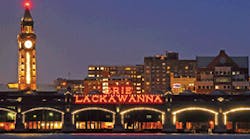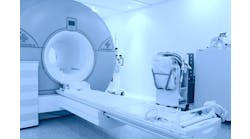Constructed in 1907, the Hoboken Ferry Terminal served as a popular transportation hub between New Jersey and New York City until more modern forms of transit and the opening of the Holland and Lincoln tunnels led to its closing in 1967. Thanks to a $120-million, multiyear redevelopment and rehabilitation project by New Jersey Transit, the ferry terminal service is once again operational.
“The Hoboken Ferry Terminal Project has been in the design and planning stages since 2002, and was divided into three phases,” explains Bruce Jabbonsky, R.A., vice president and project manager for STV, an architectural, engineering, and construction management firm providing mechanical, electrical, plumbing, and industrial engineering design services with headquarters in New York and Douglassville, Pa.
Phase One, completed in 2005, entailed underpinning and replacing the north wall of the structure. Phase Two, which was finished in 2008, involved raising a portion of the 29,000-sq-ft building’s lower-level, known as the Team Concourse, by 3 ft to compensate for the increase in tides and to avoid the periodic flooding of the Hudson River. In addition, this phase also saw the restoration of the terminal’s copper-clad south and east exterior façades.
“The east façade fronts the Hudson River, so it really needed to stand out — especially at night,” notes Jabbonsky. “It features six arched ferry slips and a large sign of the roof that says Erie-Lackawanna, which was the terminal’s original name. We used fiber-optic lighting to replace the old incandescent lamps on the arches and ferry slips. The sign on top of the building features LED strips that replicate the look of the neon tubes originally used.”
Phase Two also saw the replacement of the historic clock tower, which had been removed from the building in the 1950s due to structural instability. Like the ferry terminal building, hundreds of fiber-optic fixtures now illuminate the 225-ft clock tower.
Phase Three, completed in December, concentrated on the restoration of ferry service.
“A lack of available power at the Hoboken complex had been a problem throughout the project,” says Jabbonsky. “We were able to connect to the existing Hoboken substation, maxing it out. NJ Transit requested we design a new 15kV service, which is currently being installed to supplement power in Hoboken.”
This phase presented STV with the challenge of maintaining the building’s historic character while incorporating the infrastructure and operational needs of a contemporary ferry service.
“Because the Hoboken Ferry Terminal is on the National Register of Historic Places, the New Jersey State Office of Historic Preservation had to sign off on everything we did, including the use of materials, selection of luminaires, and types of lamps used,” Jabbonsky says.
To complicate matters, the Beaux-Arts-style building features an industrial-looking interior, which meant many of the electrical components are visible to the public.
“We spent a lot of time and effort coordinating the design of all the conduit runs, sprinkler system piping, the location of luminaires, and mechanical units to lessen the impact on the area,” says Jabbonsky. “It ended up being a very neat and clean installation. Something that could have potentially distracted from the space aesthetically doesn’t.”
According to Jabbonsky, the scope, duration, and budget constraints of the project also posed challenges.
“We were two weeks away from final design for the terminal when New Jersey Transit introduced requirements for future development,” he says. “This led us to two phases instead of one, where we had to rethink our budget while still maintaining the quality of the project and keeping our deadlines. We managed to accomplish all three.”
On Dec. 7, 2011, ferry service resumed at the Hoboken Ferry Terminal.



